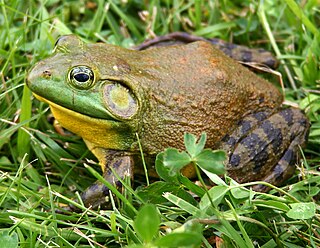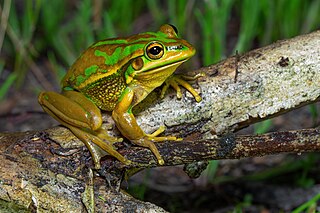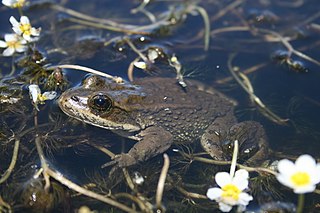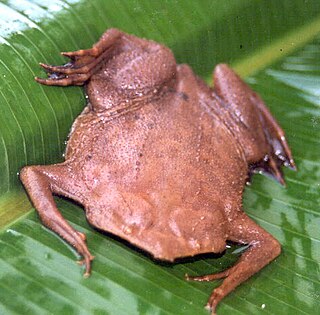
The ornate chorus frog is a species of chorus frog endemic to the Southeastern United States. Their distribution ranges from North Carolina, east to the very eastern part of Louisiana, and south to northern parts of Florida.

The American bullfrog, often simply known as the bullfrog in Canada and the United States, is a large true frog native to eastern North America. It typically inhabits large permanent water bodies such as swamps, ponds, and lakes. Bullfrogs can also be found in manmade habitats such as pools, koi ponds, canals, ditches and culverts. The bullfrog gets its name from the sound the male makes during the breeding season, which sounds similar to a bull bellowing. The bullfrog is large and is commonly eaten throughout its range, especially in the southern United States where they are plentiful.

The spring peeper is a small chorus frog widespread throughout the eastern United States and Canada. They prefer permanent ponds due to their advantage in avoiding predation; however, they are very adaptable with respect to the habitat they can live in. Due to their presence in northern regions, the frog is able to endure below freezing temperatures due to their large production glucose from their livers which acts as an anti-freeze in their blood. They are so called because of their chirping call that marks the beginning of spring. Crucifer is derived from the Latin root meaning "cross-bearing." This could be a reference to the cross-like pattern on the spring peeper's dorsal side.

Lithobates sylvaticus or Rana sylvatica, commonly known as the wood frog, is a frog species that has a broad distribution over North America, extending from the boreal forest of the north to the southern Appalachians, with several notable disjunct populations including lowland eastern North Carolina. The wood frog has garnered attention from biologists because of its freeze tolerance, relatively great degree of terrestrialism, interesting habitat associations, and relatively long-range movements.

The pickerel frog is a small North American frog, characterized by the appearance of seemingly "hand-drawn" squares on its dorsal surface.

The green and golden bell frog, also named the green bell frog, green and golden swamp frog and green frog, is a species of ground-dwelling tree frog native to eastern Australia. Despite its classification and climbing abilities, it does not live in trees and spends almost all of its time close to ground level. It can reach up to 11 cm (4.5 in) in length, making it one of Australia's largest frogs.

The Pacific tree frog, also known as the Pacific chorus frog, has a range spanning the Pacific Northwest, from Northern California, Oregon, and Washington to British Columbia in Canada and extreme southern Alaska. They live from sea level to more than 10,000 feet in many types of habitats, reproducing in aquatic settings. They occur in shades of greens or browns and can change colors over periods of hours and weeks.
The Florida bog frog is a rare species of frog found only in western Florida.

The Columbia spotted frog is a North American species of frog. It is green to brown in color with spots on the dorsal surface. The belly and upper lip are white in color. Individuals can be distinguished from other Rana species by their shorter back legs, narrow snout, and upturned eyes. Since they spend most of their time in the water, they also have more webbing in their hind feet than similar species. Although not threatened, this animal has been studied as a model species for the effects of habitat fragmentation.

The mink frog is a small species of frog native to the United States and Canada. They are so named for their scent, which reportedly smells like a mink. The scent is more akin to that of rotting onions to those unfamiliar with mink. It is also sometimes referred to as the north frog.

Gastrophryne carolinensis, the eastern narrow-mouthed toad, is a species of microhylid frog. It is a relatively small, toad-like amphibian found in damp, shady habitats. The species is highly fossorial, and feeds primarily on ants. These North American microhylids are distinguished from true toads, and other anurans by their moist, smooth skin, their lack of eardrums or tympana, their distinguishable squat body shape, and the unique fold of skin superior to their eyes. It is found in the United States, from southern Maryland to the Florida Keys, west to Missouri and Texas. While not a true toad, it is so called because it is terrestrial.

Lithobates sphenocephalus or Rana sphenocephala, commonly known as the southern leopard frog, is a medium-sized anuran in the family Ranidae. It is native to eastern North America from Kansas to New York to Florida. It is also an introduced species in some areas. This species lives in cool, clear water in the north, whereas in the south it occurs in warmer turbid and murky waters of coastal and floodplain swamps, twilight zones of caves, and abandoned mines.

The pig frog is a species of aquatic frog found in the Southeastern United States, from South Carolina to Texas. Some sources also refer to it as the lagoon frog or the southern bullfrog.

The motorbike frog is a ground-dwelling tree frog of the subfamily Pelodryadinae found in Southwest Australia. Its common name is derived from the male frog's mating call, which sounds similar to a motorbike changing up through gears; it is also known as Moore's frog, the western bell frog, western green and golden bell frog, and western green tree frog.

The oak toad is a species of toad in the family Bufonidae. It is endemic to the coastal regions of southeastern United States. It is regarded as the smallest species of toad in North America, with a length of 19 to 33 mm.

Chiasmocleis ventrimaculata, also known as the dotted humming frog, is a species of frog in the family Microhylidae. It is found in Bolivia, Brazil, Colombia, Ecuador, and Peru. Its natural habitats are subtropical or tropical moist lowland forests, swamps, and intermittent freshwater marshes.

The river frog is a species of aquatic frog in the family Ranidae. It is endemic to the southeastern United States. Its natural habitats are temperate rivers, swamps, freshwater lakes and freshwater marshes. It is threatened by habitat loss.

The carpenter frog is a species of true frog found on coastal plain of the Atlantic coast of the United States between central New Jersey and northeastern Florida.

Lithobates clamitans or Rana clamitans, commonly known as the green frog, is a species of frog native to eastern North America. The two subspecies are the bronze frog and the northern green frog.

The common Surinam toad or star-fingered toad is a purely aquatic species of frog in the family Pipidae with a widespread distribution in South America. The species is known for incubating its eggs in honeycombed chambers in the skin of the mother's back, releasing fully formed froglets after a period of 4-5 months. It is an ambush predator that lies in wait in the water for prey to come into range, which it then captures using suction feeding.




















